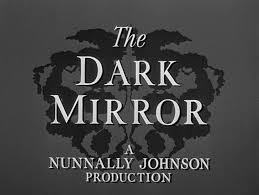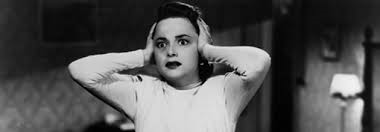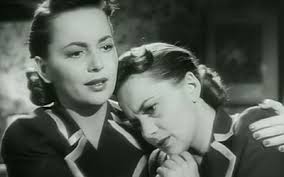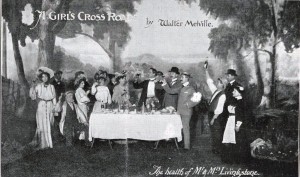Unsurprisingly quite a lot of our discussion on The Dark Mirror (1946) focused on the Doubling aspect. This was commented on in several ways: in terms of psychology, technology, Olivia de Havilland’s –performance(s), costume, doubling in terms of our comparing to other films/narratives about the Double, and finally the fact that despite the centrality of the Double in terms of the twin sisters de Havilland plays, the power in the narrative rests with two authoritarian male characters: the police detective (Thomas Mitchell) and the psychologist (Lew Ayres).
We commented that the psychological theme of the film was established very early on – during the opening credits which played over a background of different Rorschach tests, or ink blot, pictures. This particular test, which is also present in the film’s narrative, especially commented on the theme of the double in terms of its own mirroring. It was noted that the particular pictures chosen also seemed to particularly relate to the twin theme central to the film’s narrative since some of the blots appeared to resemble wombs. The doubling theme is elaborated on in relation to the Rorschach test when both Ruth and Terry (both played by de Havilland) are seen to undergo this psychological test soon after one another, but with very different results.
mirroring. It was noted that the particular pictures chosen also seemed to particularly relate to the twin theme central to the film’s narrative since some of the blots appeared to resemble wombs. The doubling theme is elaborated on in relation to the Rorschach test when both Ruth and Terry (both played by de Havilland) are seen to undergo this psychological test soon after one another, but with very different results.
The film’s use of technology while the two characters de Havilland plays appear simultaneously on the screen was praised, with only a few lighting differences obviously discernible. De Havilland’s performance(s) also aided the seamlessness. It was almost possible to forget that the actress played both parts, despite the fact the twins are identical. Character differences were evident from the start – Ruth’s timidity was contrasted to Terry’s confidence. De Havilland’s playing of these early scenes was nuanced enough to indicate Ruth and Terry’s distinct personalities, without exaggerating them. As time progressed and Terry’s ‘evil’ nature was revealed de Havilland’s facial expressions in particular became more manic. It is impressive that de Havilland also managed to convey Ruth’s apparent descent into madness with a different touch. Terry was tricking her sister into believing she herself had gone insane.  De Havilland’s performance as Ruth therefore included expressions of bewilderment and fear in contrast to Terry’s planned and controlled scheming.
De Havilland’s performance as Ruth therefore included expressions of bewilderment and fear in contrast to Terry’s planned and controlled scheming.
Costume also played an interesting role in aiding the audience’s attempt to differentiate the twins. The fact that no-one in the narrative is meant to know that there is more than one twin (the twins share a job selling magazines at a stand) explains some of their identical outfits. It seems unlikely, however, that they would necessarily need to wear identical clothes at the same time. We also wondered why the twins shared a job. Perhaps this has a practical application since one twin has, after all, we presume, committed murder and might need to be fairly closely observed by the other. Perhaps it also comments on a deeper psychological attachment. It is also the case that the twins wore the same clothes outside of work, even donning identical nightgowns. The identical costumes tailed off as the film progressed and by end evil Terry is seen all in black and innocent Ruth in a white top.
committed murder and might need to be fairly closely observed by the other. Perhaps it also comments on a deeper psychological attachment. It is also the case that the twins wore the same clothes outside of work, even donning identical nightgowns. The identical costumes tailed off as the film progressed and by end evil Terry is seen all in black and innocent Ruth in a white top.
It is telling that one of the few physical ways the twins can be differentiated is by the use of jewellery. Both own a necklace with their name featured prominently, as well as initial brooches. When Terry is impersonating Ruth, it is even seen that Ruth (and presumably Terry) owns a compact mirror with her initial engraved on it. This was particularly noticed by the group as Terry removed it from her handbag after the Doctor had started to make clear he knew her real identity. This was a very suspenseful moment – signalled, as was the case throughout the film – with dramatic music. In fact some of us thought Terry was about to brandish a gun. The necklaces, brooches and compact mirrors are items which can all be grouped under the term ‘women’s accoutrements’. Such accessories are sometimes sold, at times in connection with film stars, as ways of individuating oneself. The fact that this ‘female’ item, particularly one used to reflect on one’s appearance, is very significant. This is in terms of commenting on the theme of the double, but also because it is a replacement for the expected item – the arguably ‘male’ gun.
We noted a couple of aspects which we have previously discussed in terms of melodrama. The film’s dramatic music – and the fact that Terry uses a concealed music box to convince Ruth that the latter is going mad with auditory hallucinations – was noted. We also expressed views on the comic elements present in the film. These, usually related to the detective, seemed to sit uncomfortably with the seriousness of the film’s subject matter. They can be related to the presence of the comic subplot in some theatrical dramas –  as evidenced in our read-through of the Melville Brothers’ A Girl’s Cross Roads (1903). More specifically, a connection can be made between Mitchell’s detective and the one played by Frank Pettingell in Thorold Dickinson’s British film version of Gaslight (1940). Interestingly this is another narrative about a relative (a husband in this case) trying to send a woman mad.
as evidenced in our read-through of the Melville Brothers’ A Girl’s Cross Roads (1903). More specifically, a connection can be made between Mitchell’s detective and the one played by Frank Pettingell in Thorold Dickinson’s British film version of Gaslight (1940). Interestingly this is another narrative about a relative (a husband in this case) trying to send a woman mad.
Finally we discussed the fact that while the film provided a great showcase for de Havilland and her dual performances, the men in the narrative were afforded far more power. This is seen in the ‘active’ occupations of both the detective and the psychologist. Furthermore this is directed towards proving the guilt of the twin who has killed, Terry, the least passive of the twins. By the end of the film we presume Terry will be institutionalised, while Ruth has been safely domesticated in a romance with the psychologist.
Do, as ever, log in to comment, or email me on sp458@kent.ac.uk, to add your thoughts.




